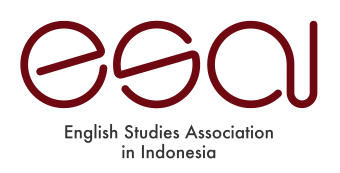Utilizing Text-to-Speech (TTS) Technology in Creating Listening Materials for English Language Teaching (ELT)
Abstract
Full Text:
PDFReferences
Agustina, N. (2017). Designing Listening Learning Media Using Adobe Flash (Undergraduate Paper 0, Universitas Esa Unggul). https://digilib.esaunggul.ac.id/UEU-Article-NA_SIEC2016/8521
Andriani, T. N., Herawati, Y. W., & Sulistyo, T. (2020, May 25). Text-to-Speech Application for Foreign Language Learner’ Listening Comprehension in Indonesia. ICONQUHAS 2018, Bandung, Indonesia. https://doi.org/10.4108/eai.2-10-2018.2295544
Apriliana, W. (2014). Developing Interactive Listening Material Using Longtion Autorun Application for 10th Grade at SMA Muhammadiyah 8 Morowudi [Undergraduate Paper, Universitas Muhammadiyah Gresik]. http://digilib.umg.ac.id/gdl.php?mod=browse&op=read&id=jipptumg--winduapril-1427&q=DEVELOPING%20INTERACTIVE%20LISTENING%20MATERIAL%20USING%20LONGTION%20AUTORUN%20APPLICATION%20FOR%2010th%20GRADE%20AT%20SMA%20MUHAMMADIYAH%208%20MOROWUDI
Ary, D., Jacobs, L. C., Irvine, C. K. S., & Walker, D. (2018). Introduction to Research in Education. Cengage Learning.
Asmar, Y., & Ardi, H. (2013). “Listening Media” Application in Preparing Listening Material. Lingua Didaktika: Jurnal Bahasa Dan Pembelajaran Bahasa, 6(2), Article 2. https://doi.org/10.24036/ld.v6i2.7416
Boardman, A. G., Garcia, A., Dalton, B., & Polman, J. L. (2021). Compose Our World: Project-Based Learning in Secondary English Language Arts. Teachers College Press.
Brown, S., & Smith, D. (2007). Active Listening 3 Teacher’s Manual with Audio CD. Cambridge University Press.
Casterson, S. (2016). Google Chromebit: A Guide for Beginners. Conceptual Kings.
Fakhruddin, Z., Usman, U., Rahmawati, R., & Sulvinajayanti, S. (2020). Designing English Listening Materials through YouTube Video Editing: Training for English Teachers of Islamic Junior High Schools Parepare. IJELTAL (Indonesian Journal of English Language Teaching and Applied Linguistics), 4(2), Article 2. https://doi.org/10.21093/ijeltal.v4i2.475
Filimowicz, M. (2019). Foundations in Sound Design for Embedded Media: A Multidisciplinary Approach. Routledge.
Fitria, T. N. (2021a). An Analysis of the Students’ Difficulties in TOEFL Prediction Test of Listening Section. ENGLISH FRANCA : Academic Journal of English Language and Education, 5(1), 95–110. https://doi.org/10.29240/ef.v5i1.2212
Fitria, T. N. (2021b). Investigating the Emergence of Digital Platforms for Listening Learning Proficiency. Al-Lisan: Jurnal Bahasa (e-Journal), 6(2), Article 2. https://doi.org/10.30603/al.v7i2.2217
Fitria, T. N. (2022). Utilizing Text-to-Speech Technology: Natural Reader in Teaching Pronunciation. JETLEE: Journal of English Language Teaching, Linguistics, and Literature, 2(2), 70–78. https://doi.org/10.47766/jetlee.v2i2.312
Gargiulo, R. M., & Bouck, E. C. (2017). Instructional Strategies for Students With Mild, Moderate, and Severe Intellectual Disability. SAGE Publications.
Goh, C. C. M., & Vandergrift, L. (2012). Teaching and Learning Second Language Listening: Metacognition in Action. Routledge.
Huang, H. (2018). Design and Implementation of a College English Listening Learning System Based on Android Platform. International Journal of Emerging Technologies in Learning (iJET), 13(07), Article 07. https://doi.org/10.3991/ijet.v13i07.8779
Johnson, D., Dobler, E., & Wolsey, T. D. (2017). Teaching the Language Arts: Forward Thinking in Today’s Classrooms. Routledge.
Karpov, A., & Potapova, R. (2021). Speech and Computer: 23rd International Conference, SPECOM 2021, St. Petersburg, Russia, September 27–30, 2021, Proceedings. Springer Nature.
Kim, T., Ma, J., Fang, W., Zhang, Y., & Cuzzocrea, A. (2012). Computer Applications for Database, Education and Ubiquitous Computing: International Conferences, EL, DTA and UNESST 2012, Held as Part of the Future Generation Information Technology Conference, FGIT 2012, Gangneug, Korea, December 16-19, 2012. Proceedings. Springer.
Locke, A. (2013). Teaching Speaking and Listening: One Step at a Time, Revised Edition. A&C Black.
Lydia, K.-B. (2015). Handbook of Research on Strategic Management of Interaction, Presence, and Participation in Online Courses. IGI Global.
Maglogiannis, I., Iliadis, L., & Pimenidis, E. (2020, May 29). Artificial Intelligence Applications and Innovations. International Conference, AIAI 2020.
Miles, M. B., & Huberman, A. M. (1994). Qualitative Data Analysis: An Expanded Sourcebook (Second Edition). SAGE Publication.
Miles, M. B., Huberman, A. M., & Saldana, J. (2013). Qualitative Data Analysis: A Methods Sourcebook. SAGE Publications.
Munday, J. B. (2016). Teaching a Child with Special Needs at Home and at School: Strategies and Tools That Really Work! WestBow Press.
Parris, H., Estrada, L., & Honigsfeld, A. (2016). ELL Frontiers: Using Technology to Enhance Instruction for English Learners. Corwin Press.
Pramadewi, P. M. M., Kesiman, M. W. A., & Darmawiguna, I. G. M. (2013). Pengembangan Aplikasi Text to Speech untuk Bahasa Bali. Jurnal Nasional Pendidikan Teknik Informatika : JANAPATI, 2(3), 219–233. https://doi.org/10.23887/janapati.v2i3.9807
Pudjiati, D., & Fitria, T. N. (2022). Digital literacy in learning listening skill between English and Non-English Department students through educational video. Leksika: Jurnal Bahasa, Sastra Dan Pengajarannya, 16(1), Article 1. https://doi.org/10.30595/lks.v16i1.13016
Raine, P. (2016). Fifty Ways to Teach with Technology: Tips for ESL/EFL Teachers. Wayzgoose Press.
Reynolds, C. R., Vannest, K. J., & Fletcher-Janzen, E. (2018). Encyclopedia of Special Education, Volume 4: A Reference for the Education of Children, Adolescents, and Adults Disabilities and Other Exceptional Individuals. John Wiley & Sons.
Scearce, L. (2016). Manual of Singing Voice Rehabilitation: A Practical Approach to Vocal Health and Wellness. Plural Publishing.
Solomon, G., & Schrum, L. (2014). Web 2.0 How-to for Educators. International Society for Technology in Education.
Stephanidis, C. (2011). Universal Access in Human-Computer Interaction. Applications and Services: 6th International Conference, UAHCI 2011, Held as Part of HCI International 2011, Orlando, FL, USA, July 9-14, 2011, Proceedings, Part IV. Springer.
Taylor, P. (2009). Text-to-Speech Synthesis. Cambridge University Press.
Watts, S. (2020). Teaching Online: Online Teaching Survival Guide: The Best Teaching Strategies and Tools for Your Online Classroom. Wryting Ltd.
Wibowo, A., & Cholifah, T. N. (2018). Instrumen Tes Tematik Terpadu: Untuk mahasiswa pendidikan guru Sekolah Dasar. Media Nusa Creative (MNC Publishing).
Yudhistiro, K. (2016). Pemanfaatan Teknologi Text-To-Speech Sebagai Media Pembelajaran Pada Laboratorium Bahasa Inggris. Jurnal Teknologi Dan Manajemen Informatika, 2(1). https://doi.org/10.26905/jtmi.v2i1.622
Zaim, M., Refnaldi, R., & Elfiona, E. (2020). Developing Mobile-Based Authentic Listening Materials for Senior High School Students. Ta’dib, 23(1), Article 1. https://doi.org/10.31958/jt.v23i1.1794
DOI: http://dx.doi.org/10.30813/jelc.v15i1.4995
Refbacks
- There are currently no refbacks.



2.jpg)



